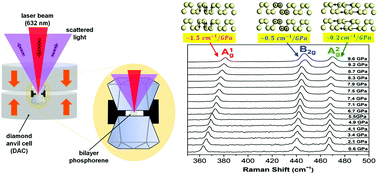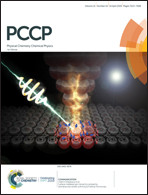Bilayer phosphorene under high pressure: in situ Raman spectroscopy†
Abstract
In this study, bilayer phosphorene samples were subjected to high pressure using a Diamond Anvil Cell (DAC) and their vibrational properties were studied via in situ Raman spectroscopy. Systematic shifting in the Raman frequency of A1g, B2g, and A2g modes was observed and theoretical calculations were performed to understand the relationship between the strain and the vibrational properties. The changes in the vibration modes under high pressure are found to reflect the deformation in the structure and its stiffness. Firstly, the study shows a substantial pressure-induced enhancement of the interactions between atoms for the out-plane mode A1g, mainly due to the directional nature of the lone pair of electrons and charge transfer. However, these interactions and the observed blue shift of the A1g Raman peak are much weaker than those in bulk black phosphorous. Secondly, while a significant enhancement of the atomic interactions due to bond length change is also observed for the in-plane mode B2g along the zigzag direction, there is almost negligible effect on the in-plane mode A2g along the armchair direction. The results add to the knowledge on mechanical properties and strain engineering in phosphorene towards novel functionalities and applications of this intriguing two-dimensional (2D) material.

- This article is part of the themed collection: 2019 PCCP HOT Articles


 Please wait while we load your content...
Please wait while we load your content...
